Báo cáo khoa học: Structure of amyloid b fragments in aqueous environments docx
Bạn đang xem bản rút gọn của tài liệu. Xem và tải ngay bản đầy đủ của tài liệu tại đây (318.5 KB, 9 trang )
Structure of amyloid b fragments in aqueous environments
Kazufumi Takano
1,2
, Shuji Endo
1
, Atsushi Mukaiyama
1
, Hyongi Chon
1
, Hiroyoshi Matsumura
3
,
Yuichi Koga
1
and Shigenori Kanaya
1
1 Department of Material and Life Science, Osaka University, Suita, Japan
2 PRESTO, Japan Science and Technology Agency (JST), Suita, Japan
3 Department of Applied Chemistry, Osaka University, Suita, Japan
Alzheimer’s disease (AD) is characterized by the
deposition of amyloid fibrils with a common cross
b-sheet structure [1]. One component of the amyloid
deposits of Alzheimer’s disease has been identified as a
39–42 amino acid polypeptide, amyloid b peptide (Ab)
[2]. Ab is derived from the proteolytic cleavage of the
amyloid precursor protein (APP), which is an integral
membrane protein [3].
Ab adopts a helix–turn–helix conformation in 2,2,2-
trifluoroethanol (TFE) [4,5], SDS [6,7], and fluorinated
alcohol [8]. However, the atomic-level crystal and
solution structure of Ab in aqueous solution without
organic solvents and detergents has not been deter-
mined. After proteolytic cleavage, Ab may remain sol-
uble but eventually aggregate into a b sheet [1]. The
initial step of the process in which Ab undergoes a
conformational transition from a soluble form to a
b structure in an aqueous environment remains unclear
because conformational study of Ab in aqueous solu-
tion is complicated by its tendency to aggregate.
Keywords
Alzheimer’s disease; crystal structure;
fusion protein; conformational transition;
hyperthermophile protein
Correspondence
K. Takano, Department of Material and Life
Science, Osaka University and PRESTO,
Japan Science and Technology Agency
(JST), 2-1 Yamadaoka, Suita, Osaka 565-0871,
Japan
Tel ⁄ Fax: +81 6 6879 4157
E-mail:
(Received 22 August 2005, revised 12
October 2005, accepted 7 November 2005)
doi:10.1111/j.1742-4658.2005.05051.x
Conformational studies on amyloid b peptide (Ab) in aqueous solution
are complicated by its tendency to aggregate. In this study, we determined
the atomic-level structure of Ab
28)42
in an aqueous environment. We
fused fragments of Ab, residues 10–24 (Ab
10)24
) or 28–42 (Ab
28)42
), to
three positions in the C-terminal region of ribonuclease HII from a hyper-
thermophile, Thermococcus kodakaraensis (Tk-RNase HII). We then exam-
ined the structural properties in an aqueous environment. The host
protein, Tk-RNase HII, is highly stable and the C-terminal region has rel-
atively little interaction with other parts. CD spectroscopy and thermal
denaturation experiments demonstrated that the guest amyloidogenic
sequences did not affect the overall structure of the Tk-RNase HII. Crys-
tal structure analysis of Tk-RNase HII
1)197
–Ab
28)42
revealed that Ab
28)42
forms a b conformation, whereas the original structure in Tk-RNase
HII
1)213
was a helix, suggesting b-structure formation of Ab
28)42
within
full-length Ab in aqueous solution. Ab
28)42
enhanced aggregation of the
host protein more strongly than Ab
10)24
. These results and other reports
suggest that after proteolytic cleavage, the C-terminal region of Ab adopts
a b conformation in an aqueous environment and induces aggregation,
and that the central region of Ab plays a critical role in fibril formation.
This study also indicates that this fusion technique is useful for obtaining
structural information with atomic resolution for amyloidogenic peptides
in aqueous environments.
Abbreviations
Ab, amyloid b peptide; AD, Alzheimer’s disease; AFM, atomic force microscope imaging; APP, amyloid precursor protein; FTIR, Fourier
transform infrared; GdnHCl, guanidine hydrochloride; TFE, 2,2,2-trifluoroethanol; ThT, thioflavine T; Tk-RNase HII, ribonuclease HII from a
hyperthermophile, Thermococcus kodakaraensis.
150 FEBS Journal 273 (2006) 150–158 ª 2005 The Authors Journal compilation ª 2005 FEBS
Ab has been investigated using its fragments. The
N-terminal region around residues 1–9 is not import-
ant for amyloid fibril formation [9]. However, in the
central region, Ab
16)22
comprises the central hydro-
phobic core that is thought to be important in full-
length Ab assembly [10–12]. Ab
11)25
has been found to
form ordered amyloid fibrils, exhibiting similar mor-
phology to that of full-length Ab [13–15]. Here, Ab
m–n
denotes residues m to n of Ab. The C-terminal region,
including residues 28–42, is highly hydrophobic and is
important for nucleation in fiber formation [16,17].
We fused two sequences, residues 10–24 (Ab
10)24
)
and 28–42 (Ab
28)42
), of Ab (Fig. 1A) to three posi-
tions in the C-terminal region of ribonuclease HII
from a hyperthermophile, Thermococcus kodakaraensis
(Tk-RNase HII) [18] in order to determine the struc-
tural properties of Ab sequences in aqueous solution.
A schematic diagram of the designed variants is shown
in Fig. 1B. Tk-RNase HII is a stable protein with 228
amino acid residues [19]. Because Tk-RNase HII is an
archaeal protein, it is not related to amyloid diseases.
The crystal structure of Tk-RNase HII
1)213
was deter-
mined and is shown in Fig. 1C [20]. Here, Tk-RNase
HII
m–n
denotes residues m to n of Tk-RNase HII. In
the structural analysis of Tk-RNase HII, a truncated
version of the protein (residues 1–213) has been deter-
mined [20]. The C-terminal region (residues 197–212)
forms a helices but makes poor interaction with other
parts. Because the fused proteins were not aggregated
in aqueous solution, we could examine their structural
properties, such as the circular dichroism (CD) spectra,
thermal stability and crystal structure. We also exam-
ined the formation of aggregates of the mutant pro-
teins using thioflavine T (ThT)-binding analysis. The
results confirmed the role of the regions in fibril forma-
tion of Ab in aqueous solution.
Results
Purification of recombinant Tk-RNase HII with
Ab fragment proteins
Upon induction for overproduction, all the fusion pro-
teins accumulated in the cells as a soluble form. These
fusion proteins were purified to give a single band on
SDS ⁄ PAGE by the same procedures used to purify the
wild-type Tk-RNase HII. These results suggest that the
addition of Ab fragments does not significantly affect
the three-dimensional structure of Tk-RNase HII
under moderate conditions.
Far-UV CD spectra
CD spectra of wild-type and mutant Tk-RNase HII
were measured in the far-UV region to examine the
effect of the Ab sequence on the overall secondary
structure of Tk-RNase HII. As shown in Fig. 2, the
shape of the spectra was almost the same for both
wild-type and mutant proteins. In particular, the value
of the negative peak at [h] 220 nm, which reflects the
characteristic a-helix structure, did not change largely.
These results indicate that a large transformation from
a-tob-conformation was not observed and that the
overall structure of the Tk-RNase HII was not dra-
matically changed by the fused Ab fragments in the
C-terminal region.
Although the secondary structures at the C-terminal
region would be locally changed or deleted in mutant
proteins, CD spectra of the mutant proteins were sim-
ilar to that of the wild-type protein. This may be that
CD signal of Tk-RNase HII is mainly from the other
eight a helices.
A
B
C
Fig. 1. (A) Sequence of amyloid b peptide
(Ab). The regions with underbars correspond
to Ab
10)24
and Ab
28)42
. (B) Schematic dia-
gram of the wild-type and designed variants
for Tk-RNase HII. (C) Crystal structure of
ribonuclease HII from a hyperthermophile,
Thermococcus kodakaraerisis (Tk-RNase HII)
[19]. Blue represents the C-terminal helix
(residues 197–212). The structures were
drawn using the program
RASMOL.
K. Takano et al. Structure of amyloid b in aqueous environments
FEBS Journal 273 (2006) 150–158 ª 2005 The Authors Journal compilation ª 2005 FEBS 151
Thermal stability
We measured heat stability to investigate the changes
in conformational stability of the Tk-RNase HII vari-
ants due to the addition of Ab fragments. Because
Tk-RNase HII is very stable against heat-induced dena-
turation [19], we added 1.2 m GdnHCl to the solution.
The heat-induced denaturation was highly reversible. It
has been reported that the heat-induced unfolding of
Tk-RNase HII does not attain equilibrium at this scan
rate because of its remarkably slow unfolding [19].
Therefore, in this study, we estimated the T
m
value for
the wild-type and mutant Tk-RNase HII proteins, as
listed in Table 1. The T
m
value changed from +2.0 to
)2.0 °C after exchange of Ab fragments at the C-ter-
minal region. These results show that fused Ab frag-
ments do not seriously affect the thermal stability of
Tk-RNase HII.
Crystal structure
For Tk-RNase HII
1)197
–Ab
28)42
, orthorhombic crys-
tals appeared under one of the crystallization condi-
tions. In the other variants we did not obtain any
diffraction-quality crystals. The crystal of Tk-RNase
HII
1)197
–Ab
28)42
diffracted to 2.8 A
˚
at a synchrotron
source. This crystal belongs to the space group P2
1
2
1
2,
having one protein molecule per asymmetric unit. The
structure of the protein was analyzed using the
molecular replacement method with the wild-type
Tk-RNase HII
1)213
structure [20] as a probe molecule.
The root mean square deviations from the ideal bond
length and the angle were 0.008 A
˚
and 1.190°. Analysis
of the stereochemistry with the program procheck
[21] demonstrated that 89.5% of the nonglycine resi-
dues were in the most favorable region of the Rama-
chandran plot; 10.5% were in the additionally allowed
region, and no residues were in the disallowed region.
The overall structure of Tk-RNase HII
1)197
–Ab
28)42
is similar to the wild-type except for the regions sur-
rounding the C-terminus, as shown in Fig. 3A. Resi-
dues 70–80 near the C-terminus changed the structure
from a small a helix to a loop, and the C-terminal helix
where Ab
28)42
was introduced was converted to a
b structure (see below). The other parts, however, have
almost the same conformations as the wild-type struc-
ture. This result confirms the small effect of Ab frag-
ments on the overall structure of Tk-RNase HII.
The electron density around the C-terminus is depic-
ted in Fig. 3B. The electron density shows that this
region, which is a helix in the wild-type structure, does
not form an a-helix conformation. The model based
on electron density indicates that the helical conforma-
tion at the C-terminus changes into a small antiparallel
b sheet (Fig. 3C). The Ab
28)42
fragment introduced
forms a b conformation even if the original structure
was an a conformation (Fig. 3D). This suggests that
the Ab
28)42
region in Ab
1)42
also retains b conforma-
tion in aqueous solution.
The new b sheet interacts with the a helix (residues
197–212). The side chain of Glu181 in the a helix
hydrogen bonds with the main chain of Leu204 (Ab–
Leu34). The side chains of Ile201, Val210 and Ile211
(Ab–Ile31, Val40 and Ile41) make a hydrophobic core
within the molecule. These interactions may stabilize
the b sheet, but the b sheet has relatively little inter-
action with other parts.
Formation of aggregates
We measured the formation of aggregates of the wild-
type and variant proteins using ThT-binding analysis
in order to determine whether the introduced amyloid-
ogenic sequences induce amyloid formation in the
host protein. Under artificial conditions, 10% TFE at
70 °C, the structure of the wild-type protein was
Fig. 2. CD spectra of the wild-type and six mutants for Tk-RNase
HII. The red line represents the wild-type protein. Black lines repre-
sent the mutant proteins. The protein concentration was
0.14 mgÆmL
)1
in 20 mM Tris ⁄ HCl at pH 8 and 25 °C.
Table 1. T
m
value for the wild-type and mutant Tk-RNase HII pro-
teins (60 °C ⁄ hin20m
M Tris ⁄ HCl, 1.2 M GdnHCl at pH 8).
T
m
(°C)
Tk-RNase HII
1-228
(WT) 77.1
Tk-RNase HII
1-212
-Ab
10)24
77.5
Tk-RNase HII
1-212
-Ab
28)42
77.5
Tk-RNase HII
1-197
-Ab
10)24
78.4
Tk-RNase HII
1-197
-Ab
28)42
75.1
Tk-RNase HII
1-174
-Ab
10)24
79.1
Tk-RNase HII
1-174
-Ab
28)42
77.2
Structure of amyloid b in aqueous environments K. Takano et al.
152 FEBS Journal 273 (2006) 150–158 ª 2005 The Authors Journal compilation ª 2005 FEBS
changed, detected by CD spectra (data not shown).
Aggregation, however, did not occur, even after
four days. Figure 4 illustrates the results. Like wild-
type Tk-RNase HII, Tk-RNase HII
1)197
–Ab
10)24
and
Tk-RNase HII
1)174
–Ab
10)24
did not aggregate. By
contrast, Tk-RNase HII
1)212
–Ab
28)42
and Tk-RNase
HII
1)174
–Ab
28)42
aggregated rapidly. Although only
Tk-RNase HII
1)212
–Ab
10)24
exhibited the formation of
aggregates among the variants with Ab
10)24
, the ten-
dency of Tk-RNase HII
1)212
–Ab
10)24
was lower than
that of Tk-RNase HII
1)212
–Ab
28)42
. We conclude that
Ab
28)42
enhances the aggregation of the host protein
more strongly than Ab
10)24
.
Discussion
Effects of A b fragment attachments on the
structure of a hyperthermophile protein
In this study, we added Ab sequences to the C-ter-
minal regions of Tk-RNase HII, which is the stable
protein from a hyperthermophile [19]. The overexpres-
sion system of Tk-RNase HII using Escherichia coli
has been constructed. It takes a monomer form in
aqueous solution [18]. The crystal structure was deter-
mined, and it was found that the C-terminal region
interacts relatively little with other parts of the mole-
cule [20]. Thus, it is thought that Tk-RNase HII is a
good model as a host protein for analyzing the struc-
tural properties of amyloidogenic peptides in aqueous
environments.
Protein purification, CD spectra and thermal dena-
turation experiments on variant proteins with Ab
sequences revealed that the overall native structure of
Tk-RNase HII was not susceptible to the exchange of
Ab sequences in the C-terminal regions, even after 15
residues were replaced and up to 39 residues were dele-
ted. This is thought to be because Tk-RNase HII is
too robust to modify the overall structural properties
and the C-terminal region of Tk-RNase HII is vari-
able.
Although the introduced Ab sequences do not seri-
ously affect the overall native conformation, some of
them induce aggregation of the host protein under
Fig. 3. (A) Overall structures of Tk-RNase HII
1)197
–Ab
28)42
and wild-type Tk-RNase HII (Tk-RNase HII
1)213
). Blue (yellow) lines represent the
wild-type (mutant) proteins. (B) Electron density around the C-terminal region of Tk-RNase HII
1)197
–Ab
28)42
.A2F
o
–F
c
map contoured at 1.2
o
´
is shown. (C) C-Terminal region of Tk -RNase HII
1)197
–Ab
28)42
. The images were prepared using O. The red dotted lines represent the
hydrogen bonds. (D) Overall structures of wild-type Tk-RNase HII (Tk-RNase HII
1)213
) (left) and Tk-RNase HII
1)197
–Ab
28)42
(right). Blue repre-
sents the C-terminal region. The structures were drawn using the program
RASMOL.
K. Takano et al. Structure of amyloid b in aqueous environments
FEBS Journal 273 (2006) 150–158 ª 2005 The Authors Journal compilation ª 2005 FEBS 153
artificial conditions. It is well known that proteins with
no relevance to amyloid disease sometimes form amy-
loid fibrils under artificial conditions in which they are
partially denatured [22–24]. In this case, some variants
of Tk-RNase HII aggregated in 10% TFE solution at
70 °C, although the wild-type Tk-RNase HII did not.
Because the stability of these variants is high, the
results represent the possibility of amyloid fibril forma-
tion by even stable proteins. Yutani et al. [25] also
report amyloid-like fibril formation by methionine
aminopeptidase from a hyperthermophile, Pyrococcus
furiosus, in the presence of 3.37 m GdnHCl at pH 3.3.
Although it has been reported that the formation of
aggregates depends on protein stability [26–29], there
was no correlation between stability and the formation
of aggregates among the proteins in this study, indica-
ting the sequence dependence of amyloidogenicity in
the case of Ab.
Tk-RNase HII
1)212
–Ab
28)42
and Tk-RNase HII
1)174
–
Ab
28)42
increased rapidly in fluorescence intensity
under ThT-binding analysis. We observed only depo-
sits, and not amyloid fibrils, of these proteins using
atomic force microscope imaging (AFM) (unpublished
data). Because these proteins bound ThT, the deposits
might be proto-filament or short fibrils. The results
indicate that only Ab
28)42
enhances aggregation of the
host protein. In contrast, Ab
10)24
showed little aggre-
gate formation. It has been reported that Ab
10)23
and
Ab
29)42
both form b sheet, but Ab
29)42
forms only
very short fibrils, whereas Ab
10)23
forms long fibrils
[15]. Furthermore, Ab
16)22
comprises the central
hydrophobic core that is thought to be important in
full-length Ab assembly [10–12]. Ab
11)25
has been
found to form ordered amyloid fibrils, exhibiting a
morphology similar to that of full-length Ab [13–15].
The study of hydrogen–deuterium exchange mapping
of Ab using NMR revealed that the middle of Ab is
involved in a b structure in the fibrils [30]. In contrast,
the C-terminal region, including residues 28–42, is
important in nucleation for fiber formation [16,17].
These results coincide with our results and suggest that
the C-terminal region of Ab induces aggregation but
not elongation of fibrils, and that the central region of
Ab plays a critical role in fibril formation. In the case
of Tk-RNase HII
m–n
–Ab
28)42
, the proteins move up to
aggregation but not to fibrils because of the lack of Ab
central region. In the case of Tk-RNase HII
m–n
–
Ab
10)24
, the proteins are not aggregated efficiently,
because of the absence of an Ab C-terminal region.
Conformation of Ab
28)42
in aqueous
environments
Structural studies of amyloid fibrils from Ab have been
performed using CD [30], X-ray fiber diffraction [32],
electron microscopy [14], and solid-state NMR [15],
and the fibrils have been well characterized. However,
the mechanism of the conformational transition from
a-helical conformation into b structure has not yet been
fully understood because the atomic-level conforma-
tions of Ab in aqueous environments are unclear. Fur-
thermore, there are some reports that soluble forms of
Ab possess intrinsic neurotoxicity [33,34], indicating the
importance of structural analysis in aqueous solutions.
In APP, Ab
1)28
is in the extracellular domain and
Ab
29)42
is in the transmembrane domain [35]. Struc-
tural analysis of Ab in membrane-mimicking solvents
indicates that Ab
28)42
takes an a-helix form [7], sug-
gesting likely a-helix formation of Ab
28)42
in the mem-
brane environment of APP. After proteolytic cleavage,
soluble nonfibrillar forms of Ab exist in the extracellu-
lar medium in vivo, whereas Ab is known to incorpor-
ate into amyloid fibrils [36]. In this study, we resolved
the crystal structure of Ab
28)42
using fusion proteins
and discovered the b-sheet formation of Ab
28)42
in an
aqueous environment. This is the first report of the
atomic-level structure of Ab fragments in aqueous
solution. The present result coincides with results from
CD spectroscopy and Fourier-transform infrared
Fig. 4. Thioflavine T-binding analysis of the wild-type and six mu-
tants for Tk-RNase HII. Wild-type (red cross), Tk-RNase HII
1)212
–
Ab
10)24
(solid squares), Tk-RNase HII
1)212
–Ab
28)42
(open squares),
Tk-RNase HII
1)197
–Ab
10)24
(solid circles), Tk-RNase HII
1)197
–
Ab
28)42
(open circles), Tk-RNase HII
1)174
–Ab
10)24
(solid triangles)
and Tk-RNase HII
1)174
–Ab
28)42
(open triangles). The protein solu-
tion (0.5 mgÆmL
)1
), in 20 mM NaOH ⁄ Cit (pH 3) with 10% TFE, was
incubated at 70 °C for 1, 2, 3, and 4 days. 20 lL of each protein
solution was added to 980 lLof5l
M ThT in 50 mM glycine ⁄ NaOH
at pH 8.5. Fluorescence intensity was measured at 446 nm excita-
tion and 482 nm emission at 25 °C.
Structure of amyloid b in aqueous environments K. Takano et al.
154 FEBS Journal 273 (2006) 150–158 ª 2005 The Authors Journal compilation ª 2005 FEBS
(FTIR) spectroscopy [9], and with the structural pre-
diction of Ab
28)42
[37]. Thus, we confirm the b confor-
mation of the region 28–42 in soluble nonfibrillar
forms of Ab. This study also demonstrates the ability
to resolve the atomic-resolution structure of Ab frag-
ments using this host–guest technique with a stable
host protein, in spite of their aggregative nature in
aqueous environments. Further studies will reveal the
conformations of other Ab fragments, including full-
length Ab.
The two most abundant forms of Ab are the 40
and 42 residue peptides, Ab
1)40
and Ab
1)42
. Both
forms are capable of assembling into b-sheet fibrils.
However, Ab
1)42
plays an important role in the path-
ogenesis of AD. The formation of aggregates and
neurotoxicity of Ab
1)42
are higher than those of
Ab
1)40
[38]. Until now, there has been no persuasive
explanation regarding this issue. This study found
antiparallel b-sheet formation in the C-terminal
region. If Ile41 and Ala42 are absent, it is difficult to
form a stout antiparallel b sheet within the molecule.
Therefore, the two C-terminal residues are important
for antiparallel b-sheet formation of soluble nonfibril-
lar forms of Ab, which would nucleate and induce
overall b-sheet fibrils. It has been reported that I41T
and A42T of Ab
1)42
have aggregative potential like
Ab
1)42
, whereas V40P, I41P and A42P hardly aggre-
gate [39], supporting the b-sheet hypothesis for the
C-terminal region in Ab.
Experimental procedures
Protein purification
The plasmids for overexpression of the mutant Tk-RNase
HII were constructed from those of the wild-type Tk-RNase
HII using standard recombinant DNA techniques. Over-
production and purification of all proteins were performed
as reported for the wild-type protein [18]. The purity of the
proteins was confirmed using SDS ⁄ PAGE. The concentra-
tion of the wild-type was estimated by assuming A
280
nm of
0.63 for a 1 mgÆmL
)1
protein [20]. The concentration of each
variant was corrected using the Trp and Tyr content [40].
CD spectroscopy
CD measurements in the far-UV region were carried out on
a J-725 automatic spectropolarimeter (Japan Spectroscopic
Co., Ltd, Hachioji, Japan). The concentration of the pro-
teins was 0.14 mgÆmL
)1
in 20 mm Tris ⁄ HCl at pH 8 and a
temperature of 25 °C. Cells with path length of 2 mm were
used. The mean residue ellipticity, h, which has units of deg
cm
2
Ædmol
)1
, was calculated.
Thermal denaturation measurement
Thermal denaturation curves for the wild-type and variant
Tk-RNase HII were determined by measuring the change in
CD at 220 nm in 0.14 mgÆmL
)1
in 20 mm Tris ⁄ HCl, 1.2 m
GdnHCl at pH 8, in 2 mm cuvettes. The measurement was
made on a J-725 automatic spectropolarimeter. The heating
rate was 60 °CÆh
)1
. The curves were analyzed by a nonlinear
least-squares analysis [41] using the following equation:
y ¼ððy
f
þ m
f
½TÞ þexpððDH
m
=RTÞððT À T
m
Þ=ðT
m
ÞÞ
Âðy
u
þ m
u
½TÞÞ=ðð1 þexpðDH
m
=RTÞððT À T
m
Þ=ðT
m
ÞÞÞ ð1Þ
Here, y
f
+ m
f
[T] and y
u
+ m
u
[T] describe the linear
dependence of the pre- and post-transitional baselines on
temperature, DH
m
is the enthalpy of denaturation at T
m
,
and T
m
is the midpoint of the thermal denaturation curve.
Curve fitting was performed using microcal origin curve-
fitting software (MicroCal, Northampton, MA).
Crystallization
The crystallization condition of the mutants of Tk-RNase
HII was initially screened using crystallization kits from
Hampton Research (Alise Viejo, CA, USA) (Crystal
Screens I, II, Cryo and Light), Emerald Biostructures
(Bainbridge Island, WA, USA) (Wizard I, II, Cryo I and
Cryo II), and Molecular Dimensions (Apopka, FL, USA)
(Stura Footprint) with a semiautomatic protein crystalliza-
tion system, TASCAL-1 (Kentoku Industry Co., Ltd, Sulta,
Japan) [42]. The crystallization condition was surveyed
using the sitting-drop vapor-diffusion method at 20 °C.
Drops were prepared by mixing 1 lL each of the protein
solution (14 mgÆmL
)1
) and the reservoir solution. The
drops were then vapor-equilibrated against 100 l L of the
reservoir solution using 96-well Corning CrystalEX Micro-
plates (Hampton Research). Single crystals of Tk-RNase -
HII
1)197
–Ab
28)42
appeared after five days using 200 mm
Mes, 11% PEG8000, and 20% Glycerol at pH 7. The cry-
stallization conditions were further optimized, resulting in
the appearance of single crystals suitable for X-ray diffrac-
tion analysis, when a microstirring technique [43] on Combi-
Clover Plates (B-Bridge, Sunnyvale, CA, USA) was used.
X-Ray diffraction and refinement
A crystal of Tk-RNase HII
1)197
–Ab
28)42
was mounted on a
CryoLoop (Hampton Research) and then flash-frozen in a
nitrogen stream at 100 K. X-Ray diffraction data on the
BL38B1 were collected at SPring-8, Japan, using a Quan-
tum 4R CCD detector (Area Detector System Corp.,
Poway, CA, USA). A total of 180 images were recorded
with an exposure time of 5 s per image and an oscillation
angle of 1°. Processing of the diffraction images and scaling
of the integrated intensities were performed using the
K. Takano et al. Structure of amyloid b in aqueous environments
FEBS Journal 273 (2006) 150–158 ª 2005 The Authors Journal compilation ª 2005 FEBS 155
program hkl2000 [44]. The data collection statistics are
shown in Table 2.
To determine the structure of Tk-RNase HII
1)197
–
Ab
28)42
, molecular replacement was performed with amore
[45], using chain A of the crystal structure of the wild-type
Tk-RNase HII (Tk-RNase HII
1)213
, PDB entry 1IO2) as a
search model. Model-building and refinement of the struc-
ture was accomplished using the programs o [46] and cns
[47]. The refinement statistics are presented in Table 1. The
coordinates of Tk-RNase HII
1)197
–Ab
28)42
have been depos-
ited in the Protein Data Bank under accession code 1·1P.
ThT-binding analysis
Amyloid quantification in solution was performed using the
ThT method [48]. The protein solution (0.5 mgÆmL
)1
), in
20 mm NaOH ⁄ Cit (pH 3) with 10% TFE, was incubated at
70 °C for 1, 2, 3, and 4 days. Twenty microliters of each
protein solution was added to 980 lLof5lM ThT in
50 mm glycine ⁄ NaOH at pH 8.5. Fluorescence intensity
was measured at 446 nm excitation and 482 nm emission
using a Hitachi F2000 spectrofluorometer (Tokyo, Japan).
Acknowledgements
This work was supported in part by a Grant-in-Aid
for National Project on Protein Structural and
Functional Analyses and by a Grant-in-Aid for
Scientific Research from the Ministry of Education,
Culture, Sports, Science, and Technology of Japan,
and by an Industrial Technology Research Grant
Program from the New Energy and Industrial Tech-
nology Development Organization (NEDO) of Japan.
The synchrotron radiation experiments were per-
formed at the BL38B1 in the SPring-8 with the
approval of the Japan Synchrotron Radiation
Research Institute (JASRI) (Proposal no. 2004A0680-
NL1-np-P3k).
References
1 Kelly JW (1998) The alternative conformations of amy-
loidogenic proteins and their multi-step assembly path-
ways. Curr Opin Struct Biol 8, 101–106.
2 Kang J, Lemaire HG, Unterbeck A, Salbaum JM,
Masters CL, Grzeschik KH, Multhaup G, Beyreuther K
& Muller-Hill B (1987) The precursor of Alzheimer’s
disease amyloid A4 protein resembles a cell-surface
receptor. Nature 325, 733–736.
3 Selkoe DJ (1998) The cell biology of beta-amyloid pre-
cursor protein and presenilin in Alzheimer’s disease.
Trends Cell Biol 8, 447–453.
4 Barrow CJ & Zagorski MG (1991) Solution structures
of beta peptide and its constituent fragments: relation to
amyloid deposition. Science 253, 179–182.
5 Sticht H, Bayer P, Willbold D, Dames S, Hilbich C,
Beyreuther K, Frank RW & Rosch P (1995) Structure
of amyloid A4-(1–40)-peptide of Alzheimer’s disease.
Eur J Biochem 233, 293–298.
6 Coles M, Bicknell W, Watson AA, Fairlie DP & Craik
DJ (1998) Solution structure of amyloid beta-peptide
(1–40) in a water–micelle environment. Is the mem-
brane-spanning domain where we think it is? Biochemis-
try 37, 11064–11177.
7 Shao H, Jao S, Ma K & Zagorski MG (1999) Solution
structures of micelle-bound amyloid beta-(1–40) and
beta-(1–42) peptides of Alzheimer’s disease. J Mol Biol
285, 755–773.
8 Crescenzi O, Tomaselli S, Guerrini R, Salvadori S,
D’Ursi AM, Temussi PA & Picone D (2002) Solution
structure of the Alzheimer amyloid beta-peptide
(1–42) in an apolar microenvironment. Similarity
with a virus fusion domain. Eur J Biochem 269,
5642–5648.
9 Hilbich C, Kisters-Woike B, Reed J, Masters CL &
Beyreuther K (1991) Aggregation and secondary struc-
ture of synthetic amyloid beta A4 peptides of Alzhei-
mer’s disease. J Mol Biol 218, 149–163.
10 Santini S, Mousseau N & Derreumaux P (2004) In silico
assembly of Alzheimer’s Abeta16–22 peptide into beta-
sheets. J Am Chem Soc 126, 11509–11516.
Table 2. Data collection and refinement statistics.
Tk-RNase HII
1-197
-Ab
28)42
Wavelength (A
˚
)0.9
Temperature (K) 100
Space group P2
1
2
1
2
Unit cell (A
˚
) 42.5, 70.2, 101.0
Resolution (A
˚
) 50.0–2.8
No. measured reflections 33,182
No. unique reflections 8,435
R
merge
(%)
a
7.1 (27.3)
Completeness (%) 95.0 (91.4)
I ⁄ o
´
I 16.8 (2.0)
R
work
⁄ R
free
(%) 24.5 ⁄ 29.8
Total atom included 1,672
Water atom included 57
Root-mean-square deviation
Bond length (A
˚
) 0.008
Bond angles (deg.) 1.190
Values in parentheses are the highest-resolution bin of respective
data.
a
R
merge
¼ S |I
hkl
–<I
hkl
>| ⁄S I
hkl
, where I
hkl
is the intensity
measurement for reflection with indices hkl and <I
hkl
> is the mean
intensity for multiply recorded reflections.
b
R
work, free
¼ S ||F
obs
|–
|F
calc
|| ⁄S |F
obs
|, where the R-factors are calculated using the
working and free reflection sets, respectively. The free reflections
comprise a random 10% of the data held aside for unbiased cross-
validation throughout refinement.
Structure of amyloid b in aqueous environments K. Takano et al.
156 FEBS Journal 273 (2006) 150–158 ª 2005 The Authors Journal compilation ª 2005 FEBS
11 Santini S, Wei G, Mousseau N & Derreumaux P (2004)
Pathway complexity of Alzheimer’s beta-amyloid
Abeta16–22 peptide assembly. Structure 12, 1245–1255.
12 Klimov DK, Straub JE & Thirumalai D (2004) Aqu-
eous urea solution destabilizes Abeta (16–22) oligomers.
Proc Natl Acad Sci USA 101, 14760–14765.
13 Petkova AT, Ishii Y, Balbach JJ, Antzutkin ON, Leap-
man RD, Delaglio F & Tycko R (2002) A structural
model for Alzheimer’s beta-amyloid fibrils based on
experimental constraints from solid state NMR. Proc
Natl Acad Sci USA 99, 16742–16747.
14 Serpell LC & Smith JM (2000) Direct visualisation of
the beta-sheet structure of synthetic Alzheimer’s amy-
loid. J Mol Biol 299, 225–231.
15 Serpell LC (2000) Alzheimer’s amyloid fibrils: structure
and assembly. Biochim Biophys Acta 1502, 16–30.
16 Jarrett JT, Berger EP & Lansbury PT Jr (1993) The car-
boxy terminus of the beta amyloid protein is critical for
the seeding of amyloid formation: implications for the
pathogenesis of Alzheimer’s disease. Biochemistry 32,
4693–4697.
17 Jarrett JT, Berger EP & Lansbury PT Jr (1993) The
C-terminus of the beta protein is critical in amyloido-
genesis. Ann NY Acad Sci 695 , 144–148.
18 Haruki M, Hayashi K, Kochi T, Muroya A, Koga Y,
Morikawa M, Imanaka T & Kanaya S (1998) Gene
cloning and characterization of recombinant RNase HII
from a hyperthermophilic archaeon. J Bacteriol 180,
6207–6214.
19 Mukaiyama A, Takano K, Haruki M, Morikawa M &
Kanaya S (2004) Kinetically robust monomeric protein
from a hyperthermophile. Biochemistry 43, 13859–
13866.
20 Muroya A, Tsuchiya D, Ishikawa M, Haruki M, Mori-
kawa M, Kanaya S & Morikawa K (2001) Catalytic
center of an archaeal type 2 ribonuclease H as revealed
by X-ray crystallographic and mutational analyses.
Protein Sci 10, 707–714.
21 Laskowski RA, Moss DS & Thornton JM (1993) Main-
chain bond lengths and bond angles in protein struc-
tures. J Mol Biol 231, 1049–1067.
22 Guijarro JI, Sunde M, Jones JA, Campbell ID &
Dobson CM (1998) Amyloid fibril formation by an SH3
domain. Proc Natl Acad Sci USA 95, 4224–4228.
23 Goda S, Takano K, Yamagata Y, Nagata R, Akutsu
H, Maki S, Namba K & Yutani K (2000) Amyloid
protofilament formation of hen egg lysozyme in highly
concentrated ethanol solution. Protein Sci 9, 369–
375.
24 Ohnishi S & Takano K (2004) Amyloid fibrils from the
viewpoint of protein folding. Cell Mol Life Sci 61, 511–
524.
25 Yutani K, Takayama G, Goda S, Yamagata Y, Maki
S, Namba K, Tsunasawa S & Ogasahara K (2000) The
process of amyloid-like fibril formation by methionine
aminopeptidase from a hyperthermophile, Pyrococcus
furiosus. Biochemistry 39, 2769–2777.
26 Funahashi J, Takano K, Ogasahara K, Yamagata Y &
Yutani K (1996) The structure, stability, and folding
process of amyloidogenic mutant human lysozyme.
J Biochem 120, 1216–1223.
27 Booth DR, Sunde M, Bellotti V, Robinson CV,
Hutchinson WL, Fraser PE, Hawkins PN, Dobson CM,
Radford SE, Blake CC et al (1997) Instability, un-
folding and aggregation of human lysozyme variants
underlying amyloid fibrillogenesis. Nature 385,
787–793.
28 Takano K, Funahashi J & Yutani K (2001) The stabi-
lity and folding process of amyloidogenic mutant
human lysozymes. Eur J Biochem 268, 155–159.
29 Goda S, Takano K, Yamagata Y, Maki S, Namba K &
Yutani K (2002) Elongation in a beta-structure pro-
motes amyloid-like fibril formation of human lysozyme.
J Biochem 132, 655–661.
30 Whittemore NA, Mishra R, Kheterpal I, Williams AD,
Wetzel R & Serpersu EH (2005) Hydrogen–deuterium
(H ⁄ D) exchange mapping of Abeta 1–40 amyloid fibril
secondary structure using nuclear magnetic resonance
spectroscopy. Biochemistry 44, 4434–4441.
31 Schladitz C, Vieira EP, Hermel H & Mohwald H (1999)
Amyloid-beta-sheet formation at the air–water interface.
Biophys J 77, 3305–3310.
32 Morozova-Roche LA, Zurdo J, Spencer A, Noppe W,
Receveur V, Archer DB, Joniau M & Dobson CM
(2000) Amyloid fibril formation and seeding by wild-
type human lysozyme and its disease-related mutational
variants. J Struct Biol 130, 339–351.
33 Roher AE, Chaney MO, Kuo YM, Webster SD, Stine
WB, Haverkamp LJ, Woods AS, Cotter RJ, Tuohy JM,
Krafft GA et al. (1996) Morphology and toxicity of
Abeta-(1–42) dimer derived from neuritic and vascular
amyloid deposits of Alzheimer’s disease. J Biol Chem
271, 20631–20635.
34 Lambert MP, Barlow AK, Chromy BA, Edwards C,
Freed R, Liosatos M, Morgan TE, Rozovsky I, Trom-
mer B, Viola KL et al. (1998) Diffusible, nonfibrillar lig-
ands derived from Abeta1–42 are potent central nervous
system neurotoxins. Proc Natl Acad Sci USA 95, 6448–
6453.
35 Marx J (1992) Alzheimer’s debate boils over. Science
257, 1336–1338.
36 Teller JK, Russo C, DeBusk LM, Angelini G,
Zaccheo D, Dagna-Bricarelli F, Scartezzini P, Bertolini
S, Mann DM, Tabaton M et al. (1996) Presence of
soluble amyloid beta-peptide precedes amyloid
plaque formation in Down’s syndrome. Nat Med 2,
93–95.
37 Soto C, Branes MC, Alvarez J & Inestrosa NC (1994)
Structural determinants of the Alzheimer’s amyloid
beta-peptide. J Neurochem 63, 1191–1198.
K. Takano et al. Structure of amyloid b in aqueous environments
FEBS Journal 273 (2006) 150–158 ª 2005 The Authors Journal compilation ª 2005 FEBS 157
38 Davis J & van Nostrand WE (1996) Enhanced patholo-
gic properties of Dutch-type mutant amyloid beta-
protein. Proc Natl Acad Sci USA 93, 2996–3000.
39 Morimoto A, Irie K, Murakami K, Masuda Y, Ohiga-
shi H, Nagao M, Fukuda H, Shimizu T & Shirasawa T
(2004) Analysis of the secondary structure of beta-amy-
loid (Abeta42) fibrils by systematic proline replacement.
J Biol Chem 279, 52781–52788.
40 Pace CN, Vajdos F, Fee L, Grimsley G & Gray T
(1995) How to measure and predict the molar
absorption coefficient of a protein. Protein Sci 4, 2411–
2423.
41 Santoro MM & Bolen DW (1988) Unfolding free energy
changes determined by the linear extrapolation method.
1. Unfolding of phenylmethanesulfonyl alpha-chymo-
trypsin using different denaturants. Biochemistry 27,
8063–8068.
42 Adachi H, Takano K, Matsumura H, Niino A, Ishizu
T, Inoue T, Mori Y & Sasaki T (2004) A semiautomatic
protein crystallization system with preventing evapora-
tion of drops and surface sensor of solution. Jpn J Appl
Phys 43, L76–L78.
43 Adachi H, Takano K, Yoshimura M, Mori Y & Sasaki
T (2003) Application of a stirring method to micro-scale
and vapor diffution protein crystallization. Jpn J Appl
Phys 42, L314–L315.
44 Otwinowski Z & Minor W (1997) Processing of X-ray
diffraction data collected in oscillation mode. Methods
Enzymol 276, 307–326.
45 Navaza J (1994) AMoRe: an automated package for
molecular replacement. Acta Crystallogr A50, 157–163.
46 Jones T, Zou JY, Cowan SW & Kjeldgarrd M (1991)
Improved methods for building protein models in elec-
tron density maps and the location of errors in these
models. Acta Crystallogr A47, 110–119.
47 Brunger AT, Adams PD, Clore GM, DeLano WL, Gros
P, Grosse-Kunstleve RW, Jiang JS, Kuszewski J, Nilges
M, Pannu NS et al. (1998) Crystallography and NMR
system: a new software suite for macromolecular struc-
ture determination. Acta Crystallogr D54, 905–921.
48 LeVine H 3rd (1993) Thioflavine T interaction with syn-
thetic Alzheimer’s disease beta-amyloid peptides: detec-
tion of amyloid aggregation in solution. Protein Sci 2,
404–410.
Structure of amyloid b in aqueous environments K. Takano et al.
158 FEBS Journal 273 (2006) 150–158 ª 2005 The Authors Journal compilation ª 2005 FEBS
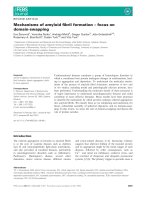
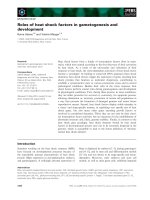
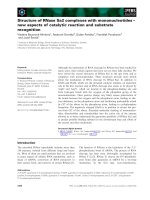
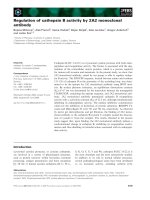
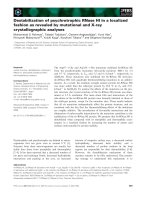
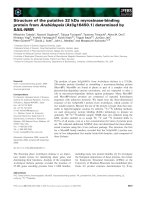
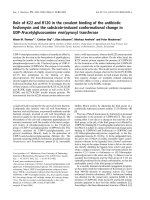
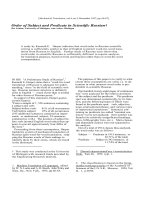
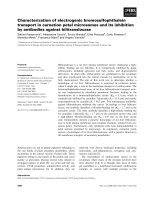
![Tài liệu Báo cáo khoa học: Expression of two [Fe]-hydrogenases in Chlamydomonas reinhardtii under anaerobic conditions doc](https://media.store123doc.com/images/document/14/br/hw/medium_hwm1392870031.jpg)